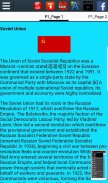








History of the Soviet Union

History of the Soviet Union ၏ ရွင္းလင္းခ်က္
The Union of Soviet Socialist Republics[b] (USSR),[c] commonly known as the Soviet Union,[d] was a socialist state in Eurasia that existed from 30 December 1922 to 26 December 1991.[9] Nominally a union of multiple national Soviet republics,[e] its government and economy were highly centralized. The country was a one-party state, governed by the Communist Party with Moscow as its capital in its largest republic, the Russian Soviet Federative Socialist Republic (Russian SFSR). Other major urban centres were Leningrad, Kiev, Minsk, Alma-Ata, and Novosibirsk.
Extending across the entirety of Northern Asia and much of Eastern Europe, the Soviet Union had spanned eleven time zones and incorporated a wide range of environments and landforms. From northwest to southeast, the Soviet Union shared land borders with Norway, Finland, Poland, Czechoslovakia, Hungary, Romania, Turkey, Iran, Afghanistan, China, Mongolia, and North Korea. It shared its maritime borders with Japan by the Sea of Okhotsk and the US state of Alaska across the Bering Strait. With an area of 22,402,200 square kilometres (8,649,500 sq mi), the Soviet Union was the largest country in the world by area, covering more than one-eighth of the Earth's inhabited land area,[10][11][12] and the third most populous, with over 288 million people as of 1989, with 80% of the population living in the western, European part of the country.
The Soviet Union had its roots in the October Revolution of 1917, when the Bolsheviks led by Vladimir Lenin overthrew the Russian Provisional Government which had replaced Tsar Nicholas II during World War I. In 1922, the Soviet Union was formed by the Treaty on the Creation of the USSR which legalized the unification of the Russian, Transcaucasian, Ukrainian and Byelorussian republics that had occurred from 1918. Following Lenin's death in 1924 and a brief power struggle, Joseph Stalin came to power in the mid-1920s. Stalin committed the state's ideology to Marxism–Leninism (which he created) and constructed a command economy which led to a period of rapid industrialization and collectivization. During this period of totalitarian rule, political paranoia fermented and the late-1930s Great Purge removed Stalin's opponents within and outside of the party via arbitrary arrests and persecutions of many people, resulting in over 600,000 deaths.[13] Suppression of political critics and forced labor were carried out by Stalin's government. In 1933, a major famine that became known as the Holodomor in Soviet Ukraine struck multiple Soviet grain-growing regions, causing the deaths of some 3 to 7 million people.[14]
In August 1939, days before the start of World War II, the Soviets signed the Molotov–Ribbentrop Pact agreeing to non-aggression with Germany, after which the two countries invaded Poland in September 1939. In June 1941, the pact collapsed as Germany turned to attack the Soviet Union, opening the largest and bloodiest theatre of war in history. Soviet war casualties accounted for the highest proportion of the conflict in the effort of acquiring the upper hand over Axis forces at intense battles such as Stalingrad and Kursk. The territories overtaken by the Red Army became satellite states of the Soviet Union and the postwar division of Europe into capitalist and communist halves would lead to increased tensions with the West, led by the United States of America.
ဆိုဗီယက်ဆိုရှယ်လစ်သမ္မတနိုင်ငံ [ခ] (ရုရှားနိုင်ငံ), [က c] လေ့ဆိုဗီယက်ယူနီယံအဖြစ်လူသိများ၏ပြည်ထောင်စု [ဃ] 26 ဒီဇင်ဘာလ 1991 30 ဒီဇင်ဘာလ 1922 ကနေတည်ရှိကြောင်း Eurasia အတွက်ဆိုရှယ်လစ်ပြည်နယ်ခဲ့ [9] မျိုးစုံအမျိုးသားရေးဆိုဗီယက်၏အမည်ခံတစ်ပြည်ထောင် [အီး] သည်၎င်း၏အစိုးရနှင့်စီးပွားရေးအလွန်အမင်းဗဟိုခဲ့ကြသည်။ တိုင်းပြည်က၎င်း၏အကြီးဆုံးသမ္မတနိုင်ငံ, ရုရှားဆိုဗီယက်ပြည်ထောင်စုဆိုရှယ်လစ်သမ္မတနိုင်ငံ (ရုရှား SFSR) တွင်ယင်း၏မြို့တော်အဖြစ်မော်စကိုနှင့်အတူကွန်မြူနစ်ပါတီကအုပ်ချုပ်တပါတီပြည်နယ်, ဖြစ်ခဲ့သည်။ အခြားအဓိကမြို့ပြစင်တာများလီနင်ဂရက်, ကိယက်ဗ်, Minsk, Alma-ATA နှင့် Novosibirsk ခဲ့ကြသည်။
မြောက်ပိုင်းအာရှနှင့်အရှေ့ဥရောပများစွာ၏တခုလုံးကိုဖြတ်ပြီးသက်တမ်းတိုးရေး, ဆိုဗီယက်ပြည်ထောင်စုတကျိပ်တပါးသောအချိန်ဇုန်သရုပ်ဆောင်ခြင်းနှင့်ပတ်ဝန်းကျင်နှင့် landforms ၏ကျယ်ပြန့ထည့်သွင်းခဲ့သည်။ အနောက်မြောက်ဘက်ကနေအရှေ့တောင်ဘက်ရန်, ဆိုဗီယက်ပြည်ထောင်စုနော်ဝေ, ဖင်လန်, ပိုလန်, အဲဒီနေ့က, ဟန်ဂေရီ, ရိုမေးနီးယား, တူရကီ, အီရန်, အာဖဂန်နစ္စတန်, တရုတ်, မွန်ဂိုလီးယားနှင့်မြောက်ကိုရီးယားနှင့်မြေယာနယ်နိမိတ် shared ။ ဒါဟာ Okhotsk ပင်လယ်နှင့် Bering Strait ဖြတ်ပြီး Alaska ၏အမေရိကန်ပြည်နယ်များကဂျပန်နှင့်အတူ၎င်း၏ရေကြောင်းနယ်နိမိတ် shared ။ 22.402.200 စတုရန်းကီလိုမီတာ (8,649,500 စတုရန်းမိုင်) ၏ဧရိယာနှင့်အတူ, ဆိုဗီယက်ပြည်ထောင်စု [10] [11] [12] ကမ္ဘာမြေရဲ့စည်ပင်မြေယာဧရိယာ၏တစ်ဦးထက်ပို-အဋ္ဌမဖုံးအုပ်, ဧရိယာအားဖြင့်ကမ္ဘာပေါ်တွင်အကြီးဆုံးနိုင်ငံတစ်ခုဖြစ်ခဲ့သည်နှင့် တိုင်းပြည်အနောက်ပိုင်းဥရောပပိုငျးတှငျနထေိုငျလူဦးရေရဲ့ 80% နှင့်အတူ 1989 ခုနှစ်၏အဖြစ်သန်း 288 ကျော်လူဦးနှင့်အတူ, တတိယလူဦးရေအများဆုံး။
ဆိုဗီယက်ပြည်ထောင်စုဗလာဒီမာလီနင်ဦးဆောင်သော Bolsheviks 1922 ခုနှစ်တွင်ပထမကမ္ဘာစစ်ကာလအတွင်း Tsar က Nicholas II ကိုအစားထိုးခဲ့သောရုရှားယာယီအစိုးရဖျက်ဆီးသောအခါ, ဆိုဗီယက်ပြည်ထောင်စုဖန်ဆင်းခြင်းအပေါ်စာချုပ်ကဖွဲ့စည်းခဲ့ပါတယ်, 1917 ၏အောက်တိုဘာတော်လှန်ရေးအတွက်၎င်း၏အမြစ်များရှိခဲ့ လီနင်ရဲ့ 1924 ခုနှစ်သေခြင်းနှင့်အကျဉ်းပါဝါရုန်းကန်ပြီးနောက် 1918 ကနေဖြစ်ပွားခဲ့သည်ခဲ့ကြောင်းရုရှား, Transcaucasian ယူကရိနျးနှင့်ဗျယ်လိုရုရှသမ္မတနိုင်ငံ၏ပေါင်းစည်းရေးတရားဝင်ဖြစ်သောဆိုဗီယက်၏, ယောသပ်စတာလင်အလယ်ပိုင်း 1920 ခုနှစ်တွင်အာဏာရလာ။ စတာလင် (သူ created) ကိုမာ့က်စ်-လီနင်မှပြည်နယ်၏သဘောတရားကျူးလွန်ခြင်းနှင့်လျင်မြန်စွာစက်မှုနှင့်ဘုံတစ်ဦးကာလမှဦးဆောင်ရသော command တစ်ခုစီးပွားရေးကိုတည်ဆောက်ခဲ့သည်။ အာဏာရှင်အုပ်စိုးမှု၏ဤကာလအတွင်းစိမ်နိုင်ငံရေးအလီယံနှင့်နှောင်းပိုင်း-1930 ဂရိတ်ရှင်းလင်းမှု 600,000 ကျော်သေဆုံးမှုအတွက်ရရှိလာတဲ့များစွာသောလူများ၏မတရားဖမ်းဆီးမှုနှင့်ညှဉ်းဆဲခြင်းမှတဆင့်ပါတီအတွင်းနှင့်ပြင်ပရှိစတာလင်ရဲ့ပြိုင်ဘက်ဖယ်ရှားခဲ့သည်။ [13] နိုင်ငံရေးဆိုင်ရာဝေဖန်သူများနှင့်အဓမ္မလုပ်အားပေးခိုင်းစေမှုများနှိမ်နင်းရေးစတာလင်ရဲ့အစိုးရကဆောင်ရွက်ခဲ့ကြသည်။ 1933 ခုနှစ်တွင်ဆိုဗီယက်ယူကရိန်းအတွက် Holodomor အဖြစ်လူသိများခဲ့သည်တဲ့အဓိကအစာခေါင်းပါးသောအခါအချို့သော 3 သန်းမှ 7 လူများ၏သေဆုံးမှုဖြစ်ပေါ်စေမျိုးစုံဆိုဗီယက်ဆနျစပါးစိုက်ပျိုးသောဒေသများလုပ်ကြံလေ၏။ [14]
သြဂုတ်လ 1939 ခုနှစ်တွင်ရက်ပေါင်းဒုတိယကမ္ဘာစစ်ရဲ့ start မှီ, ဆိုဗီယက်နှစ်နိုင်ငံဇွန်လ 1941 ခုနှစ်တွင်စက်တင်ဘာလ 1939 ခုနှစ်တွင်ပိုလန်ကျူးကျော်ဂျာမဏီလှည့်အတိုင်း, စာချုပ်ပြိုကျရာပြီးနောက်, Molotov-Ribbentrop Pact ဂျာမနီနှင့်အတူ Non-ကျူးကျော်ရန်သဘောတူလက်မှတ်ရေးထိုး သမိုင်း၌စစ်၏အကြီးဆုံးနှင့် bloodiest ပြဇာတ်ရုံဖွင့်လှစ်, ဆိုဗီယက်ပြည်ထောင်စုကိုတိုက်ခိုက်ဖို့ရန်။ ဆိုဗီယက်စစ်ထိခိုက်သေဆုံးမှုထိုကဲ့သို့သော Stalingrad နှင့် Kursk အဖြစ်ပြင်းထန်သောတိုက်ပွဲများမှာဝင်ရိုးတန်းတပ်ဖွဲ့တွေအပေါ်အသာစီးရယူများ၏ကြိုးစားအားထုတ်မှုအတွက်ပဋိပက္ခ၏အမြင့်မားဆုံးအချိုးအစားအဘို့မှတ်။ ဧဒုံတပ်မတော်အားဖြင့်ကျော်ဖြတ်အဆိုပါနယ်မြေများဆိုဗီယက်ယူနီယံ၏ဂြိုဟ်တုပြည်နယ်များဖြစ်လာခဲ့သည်နှင့်အရင်းရှင်နှင့်ကွန်မြူနစ်ရှက်သို့ဥရောပ၏စစ်ပြီးဌာနခွဲအမေရိကတိုက်၏အမေရိကန်ပြည်ထောင်စုဦးဆောင်သည့်အနောက်အုပ်စုနှင့်အတူတိုးပွားလာတင်းမာမှုများဖို့ဦးဆောင်လမ်းပြလိမ့်မယ်။
























